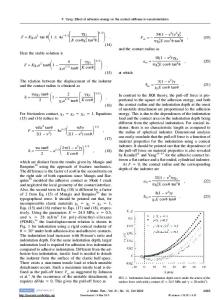Correction factor for contact area in nanoindentation measurements
- PDF / 436,398 Bytes
- 8 Pages / 612 x 792 pts (letter) Page_size
- 66 Downloads / 354 Views
n the relationship between unloading contact stiffness, elastic modulus, and contact area, which is the fundamental basic equation for nanoindentation analysis, a multiplicative correction factor is generally needed. Sometimes this correction factor is called ␥ to take into account the elastic radial inward displacements, and sometimes it is called  to correct for the fact that the indenter shape is not a perfect cone. In reality, these two effects simultaneously coexist and thus it is proposed that this correction factor is ␣ ⳱ ␥. From nanoindentation data measured on three materials of different elastic moduli with a sharp Berkovich indenter and a worn one, the tip of which was blunt, it is demonstrated that the correction factor ␣ does not have a constant value for a given material and indenter type but depends on the indenter tip rounding and also on the deformation of the indenter during indentation. It seems that ␣ increases with the tip radius and also with the elastic modulus of the measured materials.
I. INTRODUCTION
Nanoindentation experiments have become an important tool to determine the mechanical properties of materials at very low loads, especially the hardness H and the reduced Young’s modulus Er. The most commonly used method to accomplish this was introduced by Oliver and Pharr (O&P)1 and consists of the following equations H=
Pmax , Ac
S=
冉 冊 dP dh
(1) =␣
h=hmax
hc = hmax − ⑀共m兲
2
公
Er公Ac ,
Pmax , S
(2) (3)
where Pmax is the maximum indentation load, Ac is the contact area, S is the unloading stiffness, that is the unloading slope measured at the maximum depth of penetration hmax, ␣ is a correction factor the significance of which will be discussed later, hc is the contact depth at which the contact area is defined, and ⑀ a parameter generally taken as a constant equal to 0.75 but that can be
a)
Address all correspondence to this author. e-mail: [email protected] DOI: 10.1557/JMR.2005.0099 610
J. Mater. Res., Vol. 20, No. 3, Mar 2005
advantageously replaced by the function ⑀(m), as proposed and discussed by Martin and Troyon2
⑀共m兲 = m
冤
1−
冉
冉
冊
冊冥
m 2共m − 1兲 1 公⌫ 2共m − 1兲
2共m − 1兲⌫
,
(4)
where m is the exponent of the power-law relation P = B(h − hf)m which fits the unloading curve, and ⌫ is the gamma function. One important point for the determination of the hardness and the Young’s modulus is the knowledge of the contact area. As can be seen in Eq. (2), the presence of the unknown factor ␣ is a problem for determining this one experimentally. One of the objectives of this study is to discuss about the consequences on H and Er measurements of this correcting factor ␣, the discussion being based on our experimental observations. In one of the earlier papers by Pharr et al.,3 this correction factor was called  and was considered as a pure geometric factor taking into account the fact that the indenter was not a perfect cone. From finite element calculations, King4 determined that  ⳱ 1.034 for a triangular cross section as in the Berkovich indenter. Late
Data Loading...











